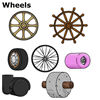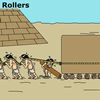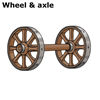 The wheel is so common now that it seems impossible to imagine life
without it. Consider some of the many wheels around you and think what
they are mainly used for. You might have thought of wheels on toys, on
a car or bike, a gear wheel, in-line skates, a grinding wheel, a steering
wheel or a potter's wheel. What about a floppy disc?
The wheel is so common now that it seems impossible to imagine life
without it. Consider some of the many wheels around you and think what
they are mainly used for. You might have thought of wheels on toys, on
a car or bike, a gear wheel, in-line skates, a grinding wheel, a steering
wheel or a potter's wheel. What about a floppy disc?
The wheel in history
 The wheel and axle system is a simple machine, used in a multitude
of more complex machines. It has become vital to your everyday life. People
probably used a log to move heavy objects along the ground, or up ramps,
many thousands of years ago.
The wheel and axle system is a simple machine, used in a multitude
of more complex machines. It has become vital to your everyday life. People
probably used a log to move heavy objects along the ground, or up ramps,
many thousands of years ago.
The first recorded use of a manufactured wheel and axle was on a clay tablet showing a Sumerian chariot about 3500 BC. The advantage of the wheel and axle was that it made it easier to carry loads on carts pulled by people or animals. Since then the wheel has been modified with cogs to make gear wheels, with buckets to form turbine wheels and becoming parts of more complex machines.
A mechanical advantage
For a wheel to have value in moving loads there must be some mechanical
advantage. In the case of a wheel and axle the ratio of force (F) to load
(L) is related to the ratio of the radius of the wheel (R) and that of
the axle (r).
 In words the mechanical advantage law is that "the force applied
multiplied by the radius of the wheel equals the load multiplied by the
radius of the axle". This can be reduced to F × R = L × r or L/F
= R/r. What this means very simply is that the larger the wheel relative
to the axle the larger the load that can be moved for a given effort.
Hence trucks and buses have bigger wheels than cars!
In words the mechanical advantage law is that "the force applied
multiplied by the radius of the wheel equals the load multiplied by the
radius of the axle". This can be reduced to F × R = L × r or L/F
= R/r. What this means very simply is that the larger the wheel relative
to the axle the larger the load that can be moved for a given effort.
Hence trucks and buses have bigger wheels than cars!
This is a calculation of the ideal mechanical advantage of the wheel. The actual mechanical advantage is less because of friction, which causes loss of energy through thermal energy and sound for example. Friction can be reduced by lubricated balls in a bearing, but transfer of energy from a source to a load can never be one hundred percent.
What mechanical advantage is provided by a car steering wheel with a diameter of about 600 mm and an axle diameter of about 50 mm? First, knowing that the radius is half the diameter, the radius of the steering wheel is 300 mm (R) and that of the axle is 25mm (r). The mechanical advantage of this system is R/r or in this case 300/25 which equals 12. This means that in theory the effort needed to move a load (the car wheel) is reduced to 1/12 of the weight of the load. Other factors come into play, such as friction, but you can see that there is a real advantage with a system like this.
| Copyright owned by the State of Victoria (Department of Education and Early Childhood Development). Used with Permission. |